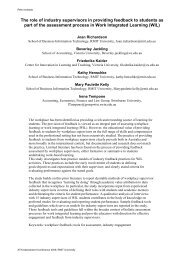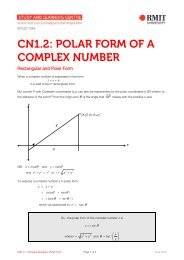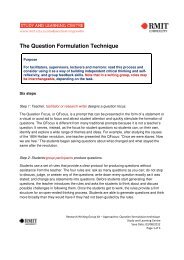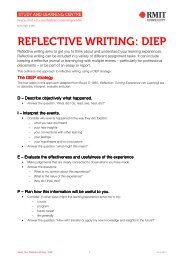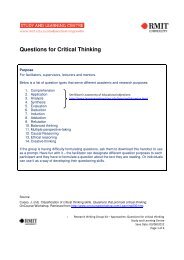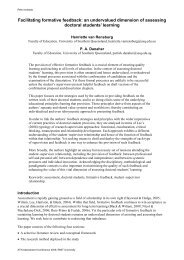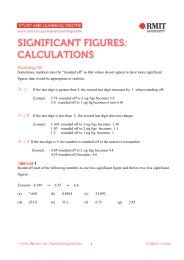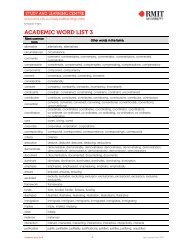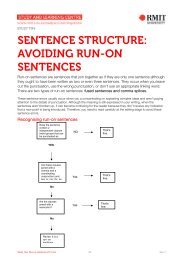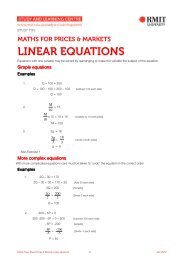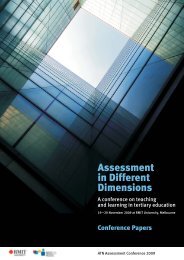student feedback and leadership - Office for Learning and Teaching
student feedback and leadership - Office for Learning and Teaching
student feedback and leadership - Office for Learning and Teaching
Create successful ePaper yourself
Turn your PDF publications into a flip-book with our unique Google optimized e-Paper software.
Student Feedback & Leadership<br />
The course material is composed of 50% Mathematics <strong>and</strong> 50% Statistics.<br />
At the beginning of the project; the mathematics component was assessed<br />
only through a number of problem sheets h<strong>and</strong>ed out to <strong>student</strong>s <strong>and</strong> they<br />
would go through them with their tutors during practice classes in a much<br />
smaller group. For the mathematics component they had 20% <strong>for</strong> assessments<br />
<strong>and</strong> 80% <strong>for</strong> the final exam. The statistics component was assessed through<br />
a 70% final exam (open book), <strong>and</strong> a 10% computer assignment (due on the<br />
final week of the semester) that would require the <strong>student</strong>s to answer a set of<br />
questions that covered all topics in the course by using the statistical computer<br />
package, MINITAB. For each question on the computer assignment, <strong>student</strong>s<br />
were asked to generate r<strong>and</strong>om data enabling each <strong>student</strong> to work with<br />
a different data set to minimize plagiarism. They had one weblearn test<br />
weighted10%, where <strong>student</strong>s could do similar online practice quizzes<br />
as many times that they wanted <strong>for</strong> practice, but could only attempt the test<br />
once. The final 10% was allocated to being up-to-date with their designated<br />
weekly problems from their text book. These problems were ticked off (but not<br />
marked) in their working note book every other week. To achieve the maximum<br />
10% <strong>student</strong>s were required to have done the assigned problems every week.<br />
Doing so would enable them to have extensive practice on topics that were<br />
covered during that week.<br />
MATH1277<br />
This is a service course taught to 90 first year <strong>student</strong>s in the second semester<br />
on both the City <strong>and</strong> Bundoora campuses <strong>and</strong> is a core component of their<br />
degree. It is a continuation of the first semester service course, Math1275.<br />
Although the <strong>student</strong>s in this course are from one discipline, there is a large<br />
variation in their mathematical abilities, typically with the Bundoora-based<br />
<strong>student</strong>s having a poorer skill set than their City-based colleagues. This<br />
course aims to equip these <strong>student</strong>s with the statistical techniques required<br />
to underst<strong>and</strong> <strong>and</strong> undertake research in their chosen field. The course<br />
is taught via face-to-face lectures <strong>and</strong> computer lab exercises. The teaching<br />
materials <strong>for</strong> the course are posted on the <strong>Learning</strong> Hub via Blackboard.<br />
The lectures in this course are presented more like an extended tutorial<br />
than a traditional lecture owing to the smaller group sizes <strong>and</strong> facilities used.<br />
At the beginning of the project, in this course the assessment comprised six<br />
computer lab exercises totalling 10%, two 20% multiple choice topic tests<br />
<strong>and</strong> a 50% multiple choice final exam. The <strong>student</strong>s were required to use both<br />
MINITAB <strong>and</strong> SPSS to complete their lab exercises which were ticked off once<br />
completed. The first topic test (conducted mid-semester) assessed material<br />
covered in the first 6 weeks of teaching <strong>and</strong> the first three computer lab<br />
exercises. Students were permitted one A4 double-sided “cheat sheet”<br />
which they were encouraged to construct on their own. The second topic<br />
test (conducted week 11) assessed material covered following the first topic<br />
test <strong>and</strong> the last three computer lab exercises, again with a single A4 doublesided<br />
“cheat sheet”. The final exam, covering all topics <strong>and</strong> lab exercises,<br />
allows <strong>for</strong> <strong>student</strong>s to utilise their two “cheat sheets” to assist them.<br />
Page 136



